Strictly necessary
These cookies ensure the website‘s technical stability.

Nancy Holt, Electrical System, 1982, detail shot, Gropius Bau, 2024
© Holt/Smithson Foundation, VG Bild-Kunst, Bonn 2024, courtesy: Sprüth Magers, photo: Luca Girardini
“Over the years these technological systems have become necessary for our everyday existence, yet they are usually hidden behind walls or beneath the earth and relegated to the realm of the unconscious. We have trouble owning up to our almost total dependence on them.” — Nancy Holt
Nancy Holt’s System Works reveal the mechanics of everyday technological structures for the circulation of electricity, heat and air. Electrical System exposes something so common to contemporary life that it often goes forgotten: light. Electricity travels through buried pipes and conduits inside the walls of a building. Holt gives sculptural presence to this power system within the built environment, pointing to the energy producing the light around us.
Electrical System is a network of arching conduits and light bulbs, which winds around the atrium. Holt referred to the work as a “fountain of light”, and visitors are invited to step inside. Electrical System is a functional sculpture, and Holt once described how the whole series of System Werks exposes “fragments of vast hidden systems, [which] are part of open-ended systems, part of the world!” Switching on a light initiates a connection to the power grid that exploits natural resources for human use. Holt invites us to physically trace a relationship to elements that usually remain unseen, asking us to become more sensitive towards our use of energy.
Nancy Holt (1938–2014) reset the limits of art, expanding the places in which it can exist and embracing the new media of her time. Across five decades, she investigated systems, perceptions and places, posing questions about how to understand our position in the world. She was part of numerous art movements that began in the 20th century including earth, land and conceptual art. Holt’s rich artistic output spans concrete poetry, audio works, film and video, photography, slide works, ephemeral gestures, drawings, room-sized installations, earthworks, artists’ books and public sculpture commissions.
Born in the United States, in Worcester, Massachusetts, Holt grew up in New Jersey. The places in which she lived would remain important sites for Holt throughout her artistic practice. She graduated with a degree in biology from Tufts University, Massachusetts in 1960. Later that year she moved to New York City where she lived and worked in a close artist community. Her artist-friends often appear in her works. Holt worked actively as an artist until her death in 2014.
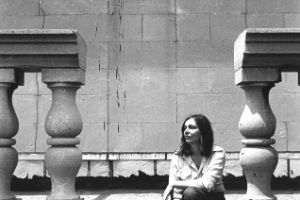
Nancy Holt on the steps up to the Clocktower Gallery in New York, 1974
© Holt/Smithson Foundation / VG Bild-Kunst, Bonn 2023, photo: Gwenn Thomas

Nancy Holt, Electrical Lighting for Reading Room, 1985, installation view, Gropius Bau, 2024
© Holt/Smithson Foundation, VG Bild-Kunst, Bonn 2024, courtesy: Sprüth Magers, photo: Luca Girardini
“My work involves making structures that focus perceptions, channeling them and giving them a depth we don’t otherwise have an opportunity to experience. l’m primarily interested in people perceiving their own perceptions.“ — Nancy Holt
Nancy Holt investigated how we sense our surroundings and the means through which awareness is shaped, as well as how the body relates to sculpture and the environment. Holt’s experiments with sight used different devices to affect the gazes of people experiencing her work. She wanted to direct both their point of focus and awareness, and used the interplay of light and shadow to alter perception.
An experience and understanding of place is often shaped through visual frameworks or structures of language. Holt’s artworks often changed the composition of these systems. The aim of this was to heighten her audiences’ consciousness and sense of interconnectedness with the environment.
The title of this exhibition, Circles of Light, has been taken from Holt’s writings. Circles recur throughout her work, becoming metaphors and tools through which to understand the world. They represent the cyclical nature and rotation of the solar system, echoing the loop of cosmic beginnings and endings. Circles are found amid her glass bulbs, tunnels, camera lenses and tubes. They take the form of devices to look through or look at, framing what we see and don’t see, what is inside and outside.
“You think of the earth turning and when you are in the center of the work you are in the center of the universe of that place.”
— Nancy Holt
Nancy Holt’s large-scale earthwork Sun Tunnels sits on the horizon line of a remote valley in Utah's Great Basin Desert and is visible from over a mile away. The work is comprised of four concrete cylinders, arranged in a cross formation. They are positioned to frame the sun as it rises and sets during the summer and winter solstices – the langest and shortest days of the year.
Small configurations of holes are punctured in the concrete, using the light emanating from the sun and moon to cast projections of star pattern constellations along the tunnel interiors. Holt was fascinated by the landscape in the west of the United States, and found its vast openness overwhelming. When standing inside the Sun Tunnels, the desert’s immensity is framed by the circular tunnels to bring, as Holt described it, “the vast space of the desert back to human scale”.
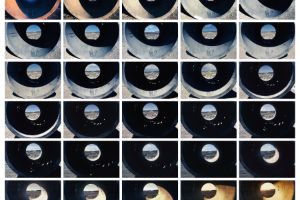
Nancy Holt, Sunlight in Sun Tunnels, 1976
© Holt/Smithson Foundation, VG Bild-Kunst, Bonn 2023, courtesy: Sprüth Magers
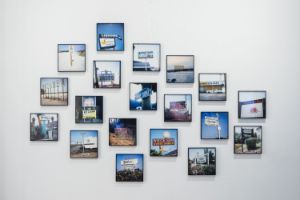
Nancy Holt, California Sun Signs, 1972, installation view, Gropius Bau, 2024
© Holt/Smithson Foundation, VG Bild-Kunst, Bonn 2024, courtesy: Sprüth Magers, photo: Luca Girardini
“When looking at something there’s a tendency for certain cards to flip in our brains, certain words to pop up in consciousness – like you see a bird and the first thing you do is name the bird, instead of just being present to the phenomenon of the bird.” — Nancy Holt
In the mid-1960s, Nancy Holt was an assistant literary editor at the magazine Harper’s Bazaar and in 1966 began creating her first concrete poems and text-based works of art. She was interested in found language and used this as material in her work, appropriating fortune cookie phrases, place names and exhibition descriptions. Holt also experimented with photocopies to explore the impact of reproduction on form and content. At the time, many artists used the photocopier, an accessible machine commonly used in offices, to replicate and dis tribute text and images.
In her 1972 journal, Holt described her fascination with making words “concrete through vision”. By experimenting with language, she created new systems of understanding. For example, she composed phrases in a particular way on the page to change conventional arrangements and syntax. The resulting concrete poems convey the ways in which language can structure and shift perception.
Her interest in how language shapes awareness also characterised her moving image and audio works. In these, she focused on certain aspects of communication, misunderstanding and the translation of observations into written and spoken words and actions. Holt’s writing practice inter spersed the research and production phases of her artworks to document her ideas and reflections.
“The wonder of place through verbal descripton.” — Nancy Holt
The voice was an important medium for Nancy Holt. She was fascinated by how verbal descriptions can frame and change perception, by the sense of a place that can be communicated through voice and sound, as well as by how voice can guide a visitor’s gaze and body.
Holt worked with audio to create multi-dimensional experiences and often used her own voice in her work to connect with listeners. She sometimes narrated what she had seen to create a feeling of the artist being present, merging her consciousness with that of the visitor.
Holt’s interest in the effects of the voice is also documented in her writings on Sun Tunnels. She describes the echoing effect of standing in the round tunnel, underlining how '“your human voice gets thrown back to you so there is a self-reference.”
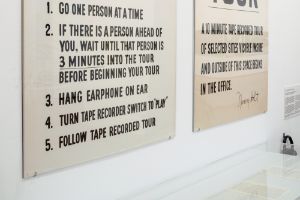
Nancy Holt, Tour of the John Weber Gallery, New York, 1972, Gropius Bau, 2024
© Holt/Smithson Foundation, VG Bild-Kunst, Bonn 2023, courtesy: Sprüth Magers, photo: Luca Girardini
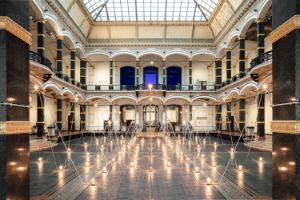
Nancy Holt, Electrical System, 1982, installation view, Gropius Bau, 2024
© Holt/Smithson Foundation, VG Bild-Kunst, Bonn 2024, courtesy: Sprüth Magers, photo: Luca Girardini
“For the last twenty-four years I have made large-scale, outdoor, site-specific sculptures. Each work evolves out of its site, with consideration given to the topography, the built environment and to local materials, along with the psychology, sociology and history of each place. Many of these works have astronomical aspects, being aligned with the sunrises and sunsets on the equinoxes and solstices, the North Star and/or the moon.” — Nancy Holt
In 1968, Nancy Holt took a trip to the desert in Nevada, which was a formative moment that made her feel fully absorbed in the landscape. She later recalled: “I had an overwhelming experience of my inner landscape and the outer landscape being identical.”
In the early 1970s, Nancy Holt began to develop earthworks, outdoor artworks taking the form of direct interventions into the surrounding landscape. They often use structural elements like pipes that are associated with systems of infrastructure. To develop these works, Holt was in close communication with researchers and expert engineers, and always sensitive to the ecological effects of the artworks on the environment.
As Holt once wrote: “Since incorporating natural elements, channeling natural substances, and being sensitive to outdoor sites are so much apart of my work, it was inevitable that ecological concerns would crop up in my art process, and that a few works with ecological aspects would be produced.”